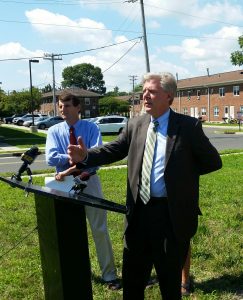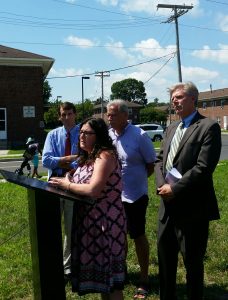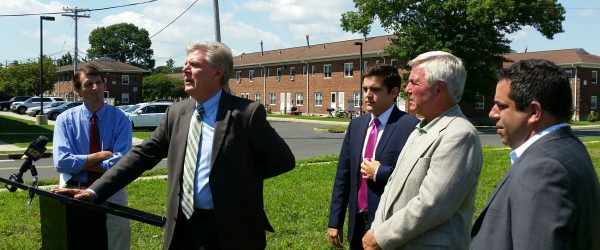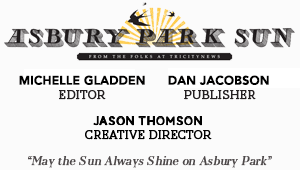Tittel: Turning Brownfields Sites into Gold
Pallone introduces legislation to reauthorize stalled funding
Across from the recently developed Springwood Avenue Park, a group of city and state environmental officials gathered alongside US Congressman Frank Pallone [D-NJ] to speak to the importance of assessing and cleaning up Brownfields sites across the state.
The site, located at Sylvan Avenue between Adams Street and Springwood Avenue, will be among those in the city to be assessed and remediated, thanks in part to a $400,000 grant awarded in May by the Environmental Protection Agency’s [EPA] Brownfields Program, Pallone said.
“I can’t say enough about the Mayor and what he and the [City] Council are doing to redevelop and make AP even greater,” Pallone [at right] said. “It’s the summer, so all you have to do is come down here one day, particularly on a Saturday night or on a Sunday during the day, and see all the things that are happening culturally in terms of redevelopment. It’s all improving the economy of Asbury Park and we see Brownfields in the same way because what we do is take old industrial sites and clean them up so they can be redeveloped.”
Pallone, who introduced new legislation in July to further the program he helped create [through legislation] in 2002, said Brownfield site remediation helps to not only cleanup contaminated sites but helps to create jobs.
“It really does have proven results,” he said of the program. “I think when we first passed it in 2002, there were about 450,000 sites around the county, almost 60,000 of them have been cleaned up since then.”
Brownfield sites are unlike the more dangerous Superfund sites, which are a part of the a national priority list and are far less in number, Pallone said. Brownfield site funding typically is administered through the state’s via federal funding.
The new legislation reauthorizes the program, which stalled in 2006. It looks to increase funding to $350 million in 2017, increasing by $50 million annually to a total of $600 million in 2022 and beyond, Pallone said. It also allows for more flexibility via inclusion of nonprofits and Community Development agencies.
“We want to that because a lot of communities have community development entities which could use the Brownfields money or they have nonprofits who can do the redevelopment, that might happen here in Asbury,” Pallone said.
The bill also allows for multipurpose awards so that assessment, cleanup and regulatory aspects can be granted under one grant, he said. More assistance has also been appropriated for disadvantaged urban and rural communities.
“I would like to personally thank Congressman Pallone, he has always been a major advocate of the City of Asbury Park,” Mayor John Moor said. “Those funding commitments and this type of legislation helps  Asbury Park continue our rebirth and revitalization.”
Asbury Park continue our rebirth and revitalization.”
In the case of this particular site, City Planner Michele Alonso [at right] said it has sat dormant for over 35 years.
“This is a key tool to redevelopment that may be hampered by unknowns on a site, such as contaminants,” Alonso said. “This gives us a helping hand in getting many of the vacant sites that you see here today developed.”
Alonso said the grant will be used to assess and help remediate not only the Sylvan Avenue site and its neighboring vacant lot, but sites along Memorial Drive, which have petro chemical containments. She said the sites were home to commercial and industrial businesses.
Asbury Park City Manager Michael Capabianco said the legislation will serve for the betterment of older communities and rural communities.
“As an urban municipality along the Jersey Shore we need help,” City Manager Michael Capabianco said. “Our economy has changed, we have a high unemployment rate, and this funding will help us put people to work, raise our tax revenue, and be able to help us provide social programs that we need to raise everyone up and bring more income and disposable income into the community.”
NJ Sierra Club Director Jeff Tittel said the legislation is not about money from the government but rather an investment in “our future and in our communities.”
“You are taking land that is fallow, that no one can be using, that is polluting the community, and you are turning it into a place for people to live and to work, to have playgrounds, and to really improve the economy and the quality of life,” Tittel said. “Every dollar that gets spent, we are going to see a ten fold increase in economic activities. We are going to pay those taxes back ten times or a hundred times by the time we are done redeveloping these sites.”
Tittel also spoke of importance of ensuring that Asbury Park’s renaissance and economic vitality continues in areas that are not located along the waterfront.
“We see Brownfields being turned into gold, a golden opportunity for economic growth and development while cleaning up and getting rid of toxic pollution,” he said “It’s also protecting Greenfields.”
Dave Pringle of the Clean Water Action [formerly NJ Environmental Federation] said too often environmental concerns are pitted against economic growth.
“Cleaning up Brownfields is really critical for the environment and the economy,” Pringle said.
“It’s not an either or, it’s a both and,” he said. “Obviously when you have contaminants in the ground that’s a problem, it’s getting into the groundwater, it’s getting into people’s basements, and it causes all kinds of health effects and problems, especially volatile organics, whether it be vapor intrusion into people’s homes and people breathing it in and getting all kinds of respiratory issues.”
Drew Tompkins of the League of Conservation Voters said given the state’s history of industry Brownfields are common occurrence throughout the state.
NJDEP estimates that the state has over 10,000 Brownfields sites, he said.
“Really we have to ask, why this bill is really important,” Tompkins said. “Brownfields are a danger and a drain on the communities where they exist. These sites hurt the local economies by producing little or no tax revenue while also having negative economic impacts on the value on the surrounding neighborhoods.
“Brownfields offer an amazing opportunity for redevelopment,” Tompkins said. “Brownfields remediation creates jobs and delivers economic benefits well above the cost. It ‘smart development’ that reclaims areas that were once in use. As a result there is less sprawl, and we can protect our limited open space while encouraging economic growth.”
Since its creation, the Brownfields Program has created more than 97,000 new jobs nationwide, according to a news release.
The $400,000 grant awarded to Asbury Park includes a $200,000 community-wide hazardous substances grant that will be used to conduct eight environmental site assessments and prepare two cleanup plans, officials said. The balance will be used to assess sites with potential petroleum contamination, along Memorial Drive.
—————————————————————————
Follow the Asbury Park Sun on Facebook, Twitter and Instagram.
The Asbury Park Sun is affiliated with the triCityNews newspaper















